K-5 Teachers Discover Strategies for Helping Students to Draw
July 31st, 2012
During the second day of the Art & Language Arts seminar, we were drawn to drawings! We explored different drawing tools, experienced a special VIP talk by a curator in our drawings department, and tried an activity that made us feel comfortable drawing—even those who were most skeptical of their artistic abilities.
For those who participated in today’s program, please share a strategy for helping students to overcome the fear of creating a drawing that doesn’t meet their expectations. How do we help students move past the idea that their pictures need to “look right”?
- Today’s media exploration encouraged teachers to build their own drawing vocabulary using different drawing tools and then create a collaborative work of art.
- Even at 8:30 AM in the morning, teachers are all smiles. Is it because of the art activity…or the delicious breakfast burritos? (Note: There’s no trace of the breakfast burrito on the plate!)
- Teachers are armed with cups of coffee and Art Stix—a winning combination!
- A painting by John Everett Millais sparked a lively discussion about what is going on in the picture. What IS going on in the picture anyway?
- Teachers spend time analyzing the clues in a painting.
- We look closely and admiringly at Joseph Mallord William Turner’s depiction of turbulent waters.
- In partners, teachers share what they see in a painting and then describe their partners’ observations.
- After discussing what they see, teachers share what the painting makes them wonder about. Then they think about possible responses to their wonderings. It’s an adaptation of the See-Think-Wonder thinking routine.
- Teachers view animals in our collection and select one to draw.
- It’s not so intimidating to draw an elephant when you break it down into different shapes.
- Two teachers successfully took on the challenge of choosing one shape and varying its size in order to create fantastic turkeys.
- A cow made up of a combination of triangles!
- Teachers discuss possible directions for their arts-integrated language arts lesson plans.
- We’re hunched over not because it’s the end of the day, but because we are imitating the pose of the figure in Jean-Francois Millet’s Man with a Hoe.
Categories:


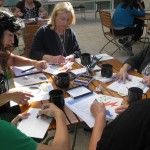



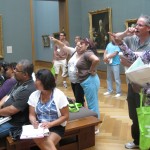
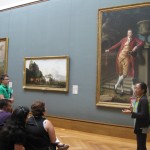
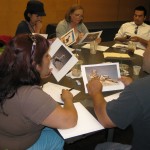
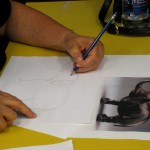
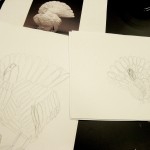
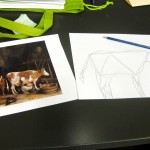


Drawing animals using onlt geometric shapes was very freeing. Another thing that we can do, is show our students drawings from artists who came after the invention of photography. This was a time of experimentation with light, color, and form. We could also show them examples from artist’s sketchbooks. Having students do quick sketches (much like a quick write) is a way to get students just get an idea on paper and not worry about the finished product.
I think that we can help students get over realism in their drawings by using a strategy similar to free writing. I will have students sit in groups of 2 – 3. They will draw or sketch the same objects, and I will time it maybe 3 – 5 mins. Students have to stop and pass the drawing to the person next to them. They will have one minute to add to their friend’s drawing and pass it on. It will be interesting to see how it works out for drawing.
The teacher could pass out a white paper that has a number on it (From 0 to 9) and tell the students that they are to use pastels, crayons, or colored pencils to make the number into an animal of their choice. They can also put the animal into an environment that will go with that animal. Since they already have a beginning place that is not normally associated with an animal, it may be less intimidating to create an animal from the number on the paper. It will be more like a game to transform one thing to another.
One way of helping students feel more comfortable drawing or sketching without the worry over realism is to expose them to sketching of simple shapes first. They may first practice sketching triangles in different sizes and different angles. By beginning with very basic activities and frequent practice in sketching, students may feel more comfortable when sketching. At the same time, we need to expose our students to works from different artists to help the students understand that an artist’s creation can be whatever the artist wants it to be.
Breaking the realism issue with the students was made simple for me today! I have dealt with students with confidence issues that could not put pencil to paper to do a sketch or original work. I have gained a powerful strategy to break that wall down. By working shapes into shapes into shapes, teachers can help those students with difficulty understanding their pictures don’t have to look perfect. By combining the simple shapes, students feel confident that they can express themselves artistically and appreciate their own works.
As I wrote this my better half told me about a K-3 reading called “Ish”, by Peter Reynolds. A wonderful story about a boy who loves to draw, then has his love crushed. With the help of his little sister, he regains his confidence and draws again. He learns that the pictures don’t have to look perfect only the quality that makes it special.
My students do sometimes feel apprehensive about drawing…because they either compare themselves to others or expect perfection of themselves. When they feel stuck or reluctant to commit pencil to paper, I first suggest they use shapes for their subjects, and I demonstrate the technique for them if they have not tried it before. Sometimes I print out a quick image or two from the internet to give them ideas. Beyond that, I suggest they get a “practice” paper and try several versions of what they are attempting. I might even pair them briefly with a kind classmate who can make suggestions and share how they would attempt the drawing. Once the practice drawing is done, the student usually feels confident enough to continue on the art paper.